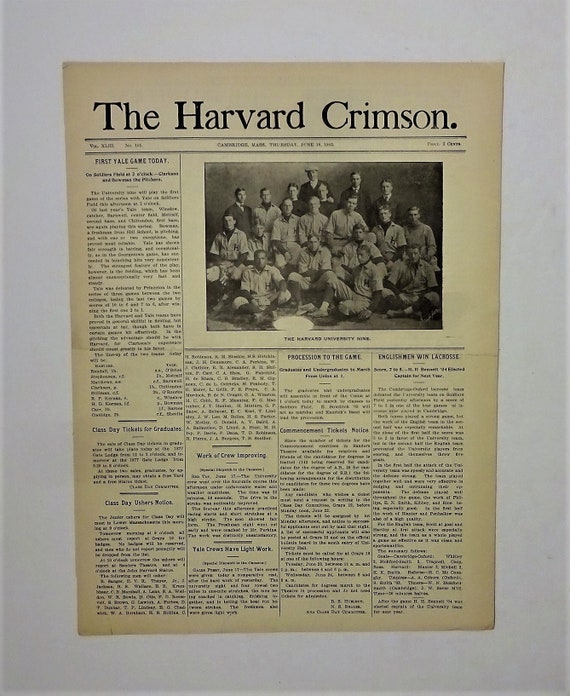Unveiling The Legacy Of The Harvard Crimson Newspaper: A Pillar Of Campus Journalism
When you think about college journalism, one name stands out like a beacon of excellence and tradition—the Harvard Crimson newspaper. Established in 1873, this iconic publication has been the voice of Harvard students for over a century, shaping countless careers and influencing generations of journalists. From its humble beginnings to its current status as one of the most respected student-run newspapers in the world, the Harvard Crimson remains a testament to the power of student journalism. It's not just a newspaper; it's a legacy that continues to inspire young minds across the globe.
But what makes the Harvard Crimson so special? Why does it continue to hold such a prominent place in the world of journalism? Well, buckle up, because we're about to dive deep into the fascinating history, impact, and legacy of this iconic publication. This isn't just a story of a newspaper—it's a story of passion, dedication, and the relentless pursuit of truth.
As we explore the Harvard Crimson's journey, we'll uncover how it has adapted to the ever-changing landscape of media while maintaining its core values. Whether you're a journalism enthusiast, a history buff, or simply curious about the inner workings of campus journalism, this article promises to deliver insights that will leave you intrigued and informed.
Read also:Rory Gilmore Actress A Comprehensive Dive Into Her Life Career And Legacy
Table of Contents
- The History of the Harvard Crimson
- Biography and Key Figures
- The Editorial Process
- Impact on Campus and Beyond
- The Digital Transition
- Challenges Faced by the Crimson
- The Legacy of the Harvard Crimson
- The Future of Campus Journalism
- Contribution to Journalism Education
- Conclusion
The History of the Harvard Crimson
Let's take a trip back in time to 1873, when a group of Harvard undergraduates decided to create a publication that would give students a voice. The Harvard Crimson was born, and it quickly became the go-to source for news, opinions, and analysis on campus. Back then, it was all about printing presses and ink-stained fingers, but the passion for storytelling never faded.
Over the years, the Crimson evolved, adapting to the changing needs of its readers. From covering historic events like the Civil Rights Movement to tackling controversial issues like university policies, the Crimson has always been at the forefront of campus journalism. Its commitment to unbiased reporting and investigative journalism has earned it respect both within and outside Harvard's ivy-covered walls.
Key Milestones in the Crimson's History
Here are some of the most significant milestones in the Harvard Crimson's storied history:
- 1920: The Crimson becomes an independent, student-run newspaper, free from university control.
- 1970: The newspaper transitions to a daily publication, increasing its reach and impact.
- 2000: The Crimson launches its website, marking the beginning of its digital era.
- 2020: Despite the challenges posed by the pandemic, the Crimson continues to publish daily, showcasing its resilience and adaptability.
Biography and Key Figures
Behind every great publication are the people who make it happen. The Harvard Crimson has been home to countless talented writers, editors, and photographers who have gone on to achieve great success in the world of journalism. Let's take a closer look at some of the key figures who have shaped the Crimson's legacy.
Here's a quick rundown of some of the most influential individuals associated with the Harvard Crimson:
| Name | Role | Notable Achievements |
|---|---|---|
| John F. Kennedy | Reporter | Future U.S. President, Pulitzer Prize-winning author |
| Robert F. Kennedy | Editor | Future U.S. Attorney General and Senator |
| Matthew V. Storin | Editor-in-Chief | Former Editor of The Boston Globe |
| Scott S. Cowen | Editor-in-Chief | Former President of Tulane University |
The Editorial Process
So, how does the Harvard Crimson produce such high-quality content day after day? The secret lies in its rigorous editorial process. From brainstorming story ideas to final edits, every step is carefully executed to ensure accuracy and excellence.
Read also:Exploring The Legacy Of Lil Wayne Albums A Journey Through His Greatest Hits
Steps in the Editorial Process
- Ideation: Editors and reporters gather to discuss potential story ideas, focusing on topics that matter to the student body.
- Research: Reporters dig deep into their chosen topics, conducting interviews, gathering data, and verifying facts.
- Writing: Once the research is complete, reporters craft their stories, paying attention to tone, structure, and clarity.
- Editing: Editors review each article, providing feedback and suggesting revisions to enhance quality.
- Publication: After final approval, the articles are published both in print and online, reaching a wide audience.
This meticulous process ensures that every piece of content produced by the Crimson meets the highest standards of journalism.
Impact on Campus and Beyond
The Harvard Crimson's influence extends far beyond the confines of the Harvard campus. Its coverage of local and global issues has sparked conversations and inspired action both within the university and in the wider community. By giving students a platform to express their thoughts and opinions, the Crimson empowers them to make a difference.
Moreover, the Crimson plays a crucial role in shaping public opinion on important matters. Whether it's advocating for social justice or critiquing university policies, the Crimson's voice is one that demands attention and respect.
Examples of the Crimson's Impact
Here are a few examples of how the Harvard Crimson has made a significant impact:
- Exposed corruption in university administration, leading to policy changes.
- Championed causes such as climate change and racial equality, influencing student activism.
- Provided in-depth coverage of political campaigns, educating students on the democratic process.
The Digital Transition
Like many traditional newspapers, the Harvard Crimson has had to adapt to the digital age. The rise of online media has brought both challenges and opportunities for the publication. While it has allowed the Crimson to reach a broader audience, it has also required the team to develop new skills and strategies.
The Crimson's website is a hub of information, featuring breaking news, opinion pieces, and multimedia content. The team has also embraced social media platforms to engage with readers and promote their work.
Challenges and Opportunities in the Digital Era
Here are some of the challenges and opportunities the Crimson has faced in the digital age:
- Challenge: Competing with professional news outlets for attention.
- Opportunity: Utilizing multimedia tools to enhance storytelling.
- Challenge: Maintaining journalistic integrity in an era of instant news.
- Opportunity: Expanding its reach to a global audience.
Challenges Faced by the Crimson
Despite its success, the Harvard Crimson faces its fair share of challenges. From financial constraints to maintaining objectivity in a polarized world, the team must constantly navigate a complex landscape. However, these challenges only serve to strengthen the publication's resolve and commitment to excellence.
One of the biggest challenges the Crimson faces is maintaining independence while relying on university resources. The team must carefully balance their relationship with the administration to ensure that their reporting remains unbiased and truthful.
Strategies for Overcoming Challenges
Here are some strategies the Crimson employs to overcome challenges:
- Seeking alternative funding sources to reduce reliance on university support.
- Encouraging diversity in the newsroom to ensure a wide range of perspectives.
- Investing in training and development to keep up with industry trends.
The Legacy of the Harvard Crimson
As we reflect on the Harvard Crimson's journey, it's clear that its legacy is one of excellence, integrity, and innovation. For over 140 years, the Crimson has been a pillar of campus journalism, shaping the careers of countless journalists and influencing the world of media.
Its commitment to truth and fairness has earned it a place in the annals of journalism history, and its impact continues to be felt today. Whether through its coverage of local issues or its exploration of global topics, the Crimson remains a beacon of hope and inspiration for aspiring journalists everywhere.
The Future of Campus Journalism
Looking ahead, the future of campus journalism appears bright, with the Harvard Crimson leading the charge. As technology continues to evolve, the Crimson will undoubtedly find new and innovative ways to engage with its audience and deliver high-quality content.
With a new generation of talented writers and editors joining the team each year, the Crimson is well-positioned to continue its tradition of excellence. Its ability to adapt to changing circumstances while staying true to its core values ensures that it will remain a pillar of campus journalism for years to come.
Contribution to Journalism Education
The Harvard Crimson's contribution to journalism education cannot be overstated. By providing students with hands-on experience in a real-world setting, the Crimson equips them with the skills and knowledge they need to succeed in the competitive world of journalism.
Through workshops, mentorship programs, and collaborative projects, the Crimson fosters an environment of learning and growth. Its alumni have gone on to achieve great success in various fields, a testament to the publication's impact on their careers.
Conclusion
As we conclude our exploration of the Harvard Crimson's legacy, it's clear that this iconic publication has left an indelible mark on the world of journalism. From its humble beginnings to its current status as a pillar of campus journalism, the Crimson has consistently delivered high-quality content that informs, inspires, and challenges its readers.
So, the next time you pick up a copy of the Harvard Crimson, take a moment to appreciate the hard work and dedication that goes into producing it. And if you're a student considering a career in journalism, remember that the Crimson offers a unique opportunity to hone your skills and make a difference in the world.
Now, it's your turn to take action! Leave a comment below sharing your thoughts on the Harvard Crimson or check out some of our other articles on campus journalism. Together, let's celebrate the power of student voices and the enduring legacy of the Harvard Crimson newspaper.


